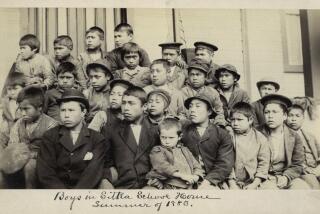Two million minutes of students’ lives
It was over dinner in Bangalore that Bob Compton began to suspect something was deeply amiss in the way America educates its young.
Compton, a successful venture capitalist, was meeting with some of the Indian software engineers he employed. He soon found himself engaged in “the most interesting conversations I’ve ever had.”
He had expected math and science nerds. But they also knew more about history, geography and literature than most Americans he knew.
“I said to them, ‘How’d you get this way?’ ” he recalled. “They said, ‘Well, at school.’ ”
That conversation launched Compton, 52, of Memphis, Tenn., on a mission. As both an entrepreneur and the father of 14- and 16-year-old girls, he wanted to know what schools in other countries were doing that American schools weren’t, and why the United States performed so miserably on international student comparisons.
The result was “Two Million Minutes,” a one-hour documentary comparing the educational experiences of six students: two Americans, two Indians and two Chinese.
The movie, in (very) limited release, begins with the premise that the high school years span roughly 2 million minutes.
How is that time spent?
Compton discussed the film, partially funded by the Bill and Melinda Gates Foundation and the Broad Foundation, over breakfast recently in Beverly Hills.
Although the documentary has not been picked up for TV or broad release, he was upbeat about the effect it was having, mostly through college screenings and DVD sales.
But something was bugging him. It was a discussion that had taken place after he screened his film at the Harvard Graduate School of Education.
“I took a brutal beating,” he said.
Compton, who has run or founded several technology and medical firms, has an MBA from Harvard and thought he was on home turf.
--
Academics resist
But one faculty member, Compton recalled, told him that “we have nothing to learn from Third World education.” Another, renowned education theorist Howard Gardner, took him to task for comparing the U.S. with China.
“His point was: How can you have a great educational system when you don’t have freedom of speech?” Compton said. Compton saw the remark as missing the point: America may not have anything to learn from China’s one-party political system, but it might want to know why Chinese students do better in math and science.
Gardner, best known for his theory of “multiple intelligences” -- which holds that different people learn in different ways -- declined to be interviewed but sent an e-mail saying that the contrast among students in the three countries is “well worth pondering.”
“On the other hand,” he wrote, “the movie’s view of what education is, and . . . what it should be, is limited and deserves a response. While excellence in science, engineering and technology are worthy goals, it is equally important to learn about history, citizenship and the arts.”
“Two Million Minutes” focuses on high-achieving students from top schools in Bangalore, Shanghai and Carmel, Ind., a suburb of Indianapolis. All are impressive, but the American students come across as slackers by comparison.
As the film begins, we hear the voice of Neil Ahrendt, an affable, well-spoken young man and a National Merit Scholarship semifinalist, saying: “Occasionally, I do homework.”
Then classmate Brittany Brechbuhl talks about the importance of balancing schoolwork and social life.
Such balance appears rare in Indian and Chinese schools.
Hu Xiaoyuan, one of the Shanghai students, wants to study biology in college but also excels at ballet and violin. Her schoolmate, Jin Ruizhang, is a math whiz who says he began pulling all-nighters in junior high.
One of the Indian students, Apoorva Uppala, is a vivacious girl whose goals are to have a stimulating career in engineering and a happy family life. In the film, she outlines a weekend day, which includes studying with a tutor:
“Yesterday -- that was Saturday -- I got up in the morning at 5:45, got dressed . . . and then had two hours of tuitions; after that did a bit of math and physics and then went to breakfast with my friends; then after that straight to school, and . . . we had classes for three hours after that -- without a break.”
The clear message is that the Indian and Chinese students work a lot harder. The movie doesn’t spend much time on curriculum or “rigor and relevance,” the kinds of issues that dominate U.S. education discussions.
The film quotes Vivek Wadhwa, a tech entrepreneur on sabbatical at Duke University, explaining why American students are slipping behind in math and science.
“The hunger isn’t there; the desire isn’t there,” he says. Chinese and Indian kids “are a lot more motivated to get into these fields and succeed, because they’re fighting starvation, they’re fighting hunger.”
How to compete with that? It isn’t easy.
Ahrendt, now at Purdue University studying computer graphics, and Brechbuhl, now at Indiana University, recently met in Washington with the two Indian students and found that they had a lot in common, including pop-culture tastes, and comparable goals. Still, Ahrendt said, “I think they just have more incentive to work harder. . . . You know, we have that incentive here, but it’s not the same driving force.”
--
Hitting a nerve
That is beginning to worry corporate America.
Raytheon Co., for instance, recently launched a website, MathMovesU.com, aimed at exciting middle-school students about math.
“We’re very concerned about the technical competency of our future workforce,” said Taylor Lawrence, a Raytheon vice president. The company, like others with sensitive government contracts, is required to hire U.S. citizens for many of its high-tech jobs.
“There’s a sense that if you look out 10, 15, 20 years, you don’t have a very robust pipeline,” he said.
Tony Wagner, a Harvard education professor, was among those who watched Compton’s film at its Cambridge screening and one of the few whose reaction was positive. Wagner studies innovation in U.S. education and has written a book due out this summer called “The Global Achievement Gap.”
Wagner said Compton hit a nerve at Harvard because he was confronting an implacable divide between the American business community and the education establishment.
He agrees with Compton’s central thesis.
“We don’t challenge kids in schools,” he said. “We don’t challenge them to think; we don’t challenge them to create. We challenge them to get good enough grades to get into a good enough college.”
Wagner believes the solution is an overhaul of American education to emphasize innovation and critical thinking, not simply working harder at math and science.
“I’m suggesting that Bob is right, but not that the answer is the Chinese or Indian model,” he said. “In this country, it’s a different challenge.”
--
mitchell.landsberg@latimes.com
More to Read
Sign up for Essential California
The most important California stories and recommendations in your inbox every morning.
You may occasionally receive promotional content from the Los Angeles Times.










